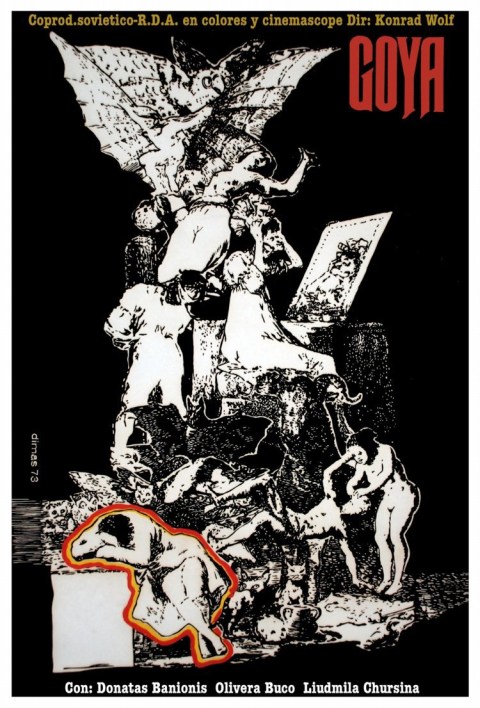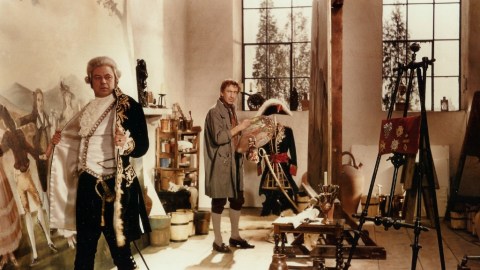17. 4. – 19. 4. 2026
Goya

 Original title: Goya - oder Der arge Weg der Erkenntnis
Original title: Goya - oder Der arge Weg der ErkenntnisDirector: Konrad Wolf
Production: 1971, East Germany / USSR / Bulgaria / Yugoslavia
Length: 136 min.
Screened:
70mm film seminar 2009: 70mm 2.2:1, Colours partly faded, MG, Spoken language: German, Subtitles: CzechKRRR! 2017: 70mm 2.2:1, Colours partly faded, MG, Spoken language: German, Subtitles: Czech
Annotation for KRRR! 2017
Art can be suppressed, but never silenced, because any ideology is defenseless against the truth.
The biographical drama Goya was created in cooperation between the Soviet studio LENFILM and the East German studio DEFA, directed by Konrad Wolf, based on the novel of the same name by Lion Feuchtwanger. It is one of ten 70mm films that were created by the DEFA studio in the 1960s, and is among the Soviet co-productions that were supposed to be able to compete with American productions. Goya was filmed in several countries with an international cast, led by Lithuanian actor Donatas Banionis. The resulting (originally almost three-hour) opus was awarded the Special Jury Prize at the Moscow IFF in 1971 and also won several awards in its second homeland in the GDR.
The plot takes us to Spain, plagued by the Inquisition, in the period before the war with Napoleonic France. Don Francisco de Goya gains the position of a prominent court painter, but faces conflicting feelings of loyalty to the court and the church on the one hand and solidarity with ordinary people on the other. He experiences inner torment, which is intensified by a destructive relationship with the Duchess of Alba, to whom he is bound by immense passion and despises at the same time. The film charts the gradual development of his artistic work and the process of awareness. Goya's work becomes a provocative and controversial tool for revealing the truth and aims to create a historical document of his time. Banionis's initially expressive speech also changes accordingly. As if he has now put all his energy into his art, Goya seems disjointed, while his work gains strength. Like the series of engravings Los Caprichos, Goya captures the complexity of the portrait subject. The work with sound and the editing composition are influenced by the subjective experience of the main character. The cinematography by Werner Bergmann and Konstantin Ryshow amazes with its grandeur (similar to the set design, which includes 3,000 costumes and 80 painting reproductions) and its attention to detail. The shots themselves are often not far from tableau vivant and evoke paintings thanks to the elaborate composition of the image in several shots and the shallow depth of field, which surrounds the figures with a colorful background with unclear contours.
Goya is not an ordinary biographical film or portrait that would primarily point out the exceptionality of the artist or convey the process of creating a work of art. Konrad Wolf instead focuses on the role of the artist in society and the relationship between art and power. He celebrates the ability of art to become not only a historical document, but also an agent of social change, and reflects on the ability of art to be the bearer of multiple meanings. The meaning is not fixed to any work, but is influenced by its recipient, and the ruling authorities can therefore never have complete control over the interpretation. In his time, Goya was therefore also understood as an indirect reaction to attacks against filmmakers and other artists – Goya plays out a similar game with the Inquisition about the (un)intended meanings of works of art, such as the one artists played with censorship.
Annotation for 70mm film seminar 2009
Buñuel, Saura, Forman – names perhaps a little better known than Konrad Wolf, who was one of the prominent creators in the former GDR, although he remains a figure that is not entirely clearly defined for historians. Wolf’s film about Goya, a transcription of Lion Feuchtwanger’s book of the same name Goya, or the Bitter Journey of Knowledge, is considered by many (among a number of others) to be one of the best. It can also be understood as an allegory of the time of its creation and the life of the director himself. Milan Klepikov writes, among other things, about the film “which poses as a historical depiction of a completely different era. Wolf’s Goya is the universally recognized first painter in the country, admired by opposition liberals as well as members of the royal court, who bestow upon him decorations, orders and honorary positions. Goya does not want to be an official ‘state’ artist, but remains in this role, endowed with a healthy dose of peasant opportunism. Goya does not want to be a rebel, but his paintings themselves, read by liberals completely differently than the rulers depicted in them, bring him into the ranks of the opposition.” The co-production was produced by the East German company DEFA as one of a total of ten films (3 documentaries and 7 feature films) that were shot in the GDR in the late 1960s and early 1970s (when the production of these films was terminated mainly for financial reasons) in the 70mm format, in the DEFA 70 system. It is reported that cinematographer Bergmann and his Soviet colleague Ryšov wanted to apply their own creative principles when working with the wide-angle format and thus distinguish themselves from Western cinematography. After the premiere, the director decided to cut the film from the original length of 161 min. to the final 134 or 136 min., which is the only available version of the film. It is also the first 70mm film to be dubbed into six-channel sound in our country in 1972. Special Jury Prize at the Moscow Film Festival in 1971. Starring Donatas Banionis (Solaris).